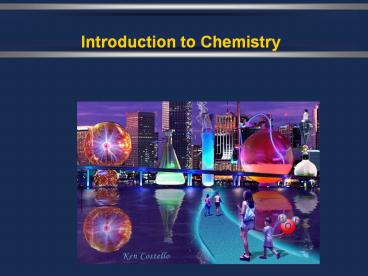Introduction to Chemistry - PowerPoint PPT Presentation
1 / 39
Title:
Introduction to Chemistry
Description:
Title: II. Units of Measurement Author: Mrs. Johannesson Last modified by: CCSD Created Date: 7/4/2000 12:24:44 AM Document presentation format: On-screen Show (4:3) – PowerPoint PPT presentation
Number of Views:48
Avg rating:3.0/5.0
Title: Introduction to Chemistry
1
Introduction to Chemistry
2
Chemistry
The study of the composition, structure, and
properties of matter, the processes that matter
undergoes, and the energy changes that accompany
these processes.
3
Branches of Chemistry
- Organic carbon containing compounds
- Inorganic metals and anything not organic
- Physical properties / changes / energy
- Analytical identification and composition of
materials - Biochemistry living things
- Theoretical math computers to understand
4
Research Technology
- Basic Research for the sake of knowledge
- Applied Research to solve a problem
- Technological Development improve quality of
life
5
Matter is anything that has mass and takes up
space.
6
- Mass is a measure of the amount of matter.
- Volume is the amount of space an object occupies.
7
Building Blocks of Matter
- Atom smallest unit of an element that maintains
the chemical identity of that element. - Element pure substance that cannot be broken
down into simpler, stable substances and is made
of one type of atom.
8
- Compound substance that can be broken down into
simple stable substances. Each compound is made
from the atoms of two or more elements that are
chemically bonded.
9
Extensive Properties
depend on the amount of matter present.
- Volume
- Mass
- Amount of energy
10
Intensive Properties
do not depend on the amount of matter present.
- Melting Point
- Boiling Point
- Density
- Electrical Conductivity
11
Physical Properties
can be observed or measured without changing the
identity of a substance.
- Density
- Color
- Melting point
12
Chemical Properties
relate to a substances ability to undergo
changes that transform it into a different
substance.
- Flammability (tendency of a substance to burn in
air) - Reactivity
- Toxicity
13
Physical Changes
- If it is still the same substance when you are
done with it, it is a physical change. - Ex Crushing, tearing, Evaporating Water (still
H2O), any phase change.
14
Chemical Changes
- If it is NOT the same substance when you are done
with it, it is a chemical change. - Ex Cooking or burning something, Rusting metal.
15
How Do You Know?
- Chemical Change Bubbling, color change,
temperature change.
16
Energy
- Energy is always either used or given off in any
physical or chemical change. - Energy cannot be created or destroyed (Law of
Conservation of Energy).
17
Ask Yourself
- Has the change altered the identity of the
substance? - If yes Chemical Change
- If no Physical Change
18
States of Matter
- Solid definite shape and definite volume.
19
States of Matter
- Liquid indefinite shape but definite volume
takes shape of container.
20
States of Matter
- Gas no definite shape or volume expands to
fill container and takes shape of container.
21
States of Matter
- Plasma no definite shape or volume a high
temperature state where atoms lose most of their
electrons.
22
States of Matter
23
Changes in State
24
Changes in Matter
25
Classification of Matter
- Mixture A blend of two or more kinds of matter,
each of which retains its own identity and
properties. Can be separated. - Pure Substance Has a fixed composition.
26
Pure Substances
- Compounds (Ex water, sodium chloride, sucrose)
- Elements (Ex gold, aluminum, oxygen, chlorine)
27
Mixtures
- Homogeneous same throughout
- (Ex air, stainless steel, solutions like
sugar-water) - Heterogeneous not the same throughout (Ex
granite, wood, blood)
28
Separating Mixtures
- Filtration pour liquid through paper that
catches solid and lets liquid pass through. - Can only be used on a heterogeneous mixture of a
liquid and a solid.
29
Separating Homogeneous Mixtures by
- Distillation
- Crystallization
- Chromatography
30
Separating Homogeneous Mixtures
- Chromatography solution is separated by
allowing it to flow along a stationary substance.
31
Separating Homogeneous Mixtures
- Distillation separates by different boiling
points.
32
Separating Homogeneous Mixtures
- Crystallization boil off or evaporate off the
liquid and you are left with the solid.
33
Intro to Periodic Table
34
Organizing the Squares
- Metals
- Nonmetals
- Metalloids
- Groups or families
- Vertical columns
- Groups have similar chemical and physical
properties. - Periods
- Horizontal Rows
35
Properties of Metals
- Luster - shiny
- Conduct Electricity Heat
- Malleable hammered into thin sheets
- Ductile drawn into wire
36
Properties of Non-Metals
- No Luster not shiny
- Nonconductors
- Brittle
- Non-Ductile
Helium
SULFUR
37
Properties of Metalloids
- Also called semimetals
- Have properties of both metals and non-metals.
- B, Si, Ge, As, Sb
38
Group Names
- Alkali Metals
- Alkaline Earth Metals
- Transition Metals
- Halogens
- Noble Gases
39
Noble Gases
- Inert Gases do not readily react.
- Are gases at room temperature.

